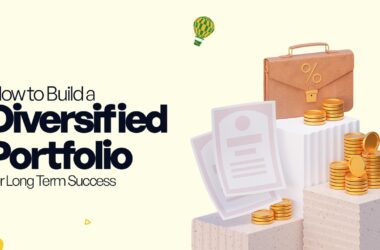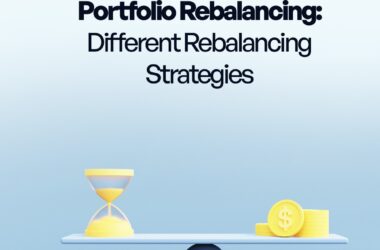An investment portfolio is essentially a carefully curated collection of assets that aims to achieve specific financial goals while managing risk effectively. Having a well-constructed portfolio is crucial for building and protecting your financial future.
Curious about how to create a solid investment portfolio? You’ve come to the right place.
In this guide, I’ll explain what an investment portfolio is, why it’s important, and how to build one step by step.
What is an Investment Portfolio?
An investment portfolio is a collection of financial assets like stocks, bonds, and ETFs (Exchange-traded funds) curated with the expectations that they would yield returns, grow in value, or do both.
Why is an Investment Portfolio Important?
Building an investment portfolio is a key part of a sound financial plan. It helps achieve financial stability and security. Here’s why it matters:
1. Diversification
An investment portfolio allows you to diversify across assets, such as stocks, bonds, and real estate. This minimizes the impact of market volatility, reducing overall risk.
By investing in a variety of assets such as stocks, bonds, mutual funds, and real estate, investors can reduce the impact of market volatility on their overall returns.
2. Steady Income Streams
A well-diversified portfolio provides steady income through interest, dividends, and capital gains. This helps you achieve long-term financial goals, such as retirement or major projects.
How to Build an Investment Portfolio
A great start to succeeding as an investor is to have an investment portfolio. You need to know how to create one that fits into your goals and timeline. Here are 4 steps to take in building an investment portfolio.
Step 1: Decide Your Asset Allocation
Asset allocation is about aligning your financial goals, risk tolerance, and investment horizon. Ask yourself:
Why are you investing? For retirement or a short-term project?
How much risk can you tolerate? Are you conservative or aggressive? For example, a conservative investor might allocate more to bonds, while an aggressive investor leans toward stocks.
How long do you plan to hold your investments? If you’re saving for retirement, you’ll likely leave your investment for the long term. Whereas, if you’re a young person looking to make ends meet, you’d likely invest for short-term periods.
When creating your asset allocation, it’s better to diversify between high-risk investments that can potentially bring high returns and moderate-risk investments that would likely yield moderate returns. That way, you’re getting the best of both worlds.
Step 2: Choose your Asset
After you’ve decided on your goals, risk tolerance, and duration of investment, you proceed to allocate your assets in percentages across different financial assets using your risk assessment. Let’s work with stocks, bonds, ETFs, and mutual funds.
- Stock Picking
When you buy stocks, you own a small part of a company. People buy stocks because they think the price of the stock will go up. However, there is also a risk that the stock price will not increase or might even go down. To select stocks for your portfolio, pick the ones within your risk tolerance (low-risk, moderate risk, or high/aggressive risk tolerant).
You should also consider factors like the sector, market capital, and type of stock. You should also dedicate time to monitoring the changes in the stock price and company news so you can adjust stock volume as needed. You can learn more about buying stocks.
2. Bond Picking
Bonds are long-term, interest-bearing loans to businesses or governments. They are safer investments with low risks but their returns are lower than stocks. Bonds are known as fixed-income investments because you know how much interest you get in return as you invest.
This fixed rate of return for bonds can balance out other riskier investments, like stocks in your investment portfolio. When selecting bonds, factors such as a coupon, maturity, bond type, credit rating, and the general interest-rate environment should be taken into account.
3. Mutual Funds
Mutual funds offer a variety of asset classes and are managed by professional fund managers who pick stocks and bonds for the portfolio. However, the management fee charged by the fund managers will affect your returns. Index funds are passively managed and have lower fees since they mirror an established index.
4. ETFs
If you’re looking for an alternative to mutual funds, ETFs are a great option. They’re like mutual funds but they trade like stocks. They are grouped by sector, capitalization, and country and passively track a chosen index or another basket of stocks, offering diversification and cost savings over mutual funds. ETFs can be used to complement your investment portfolio by covering a broad range of asset classes.
Read Also: How Long Should I Leave my Investment?
Step 3: Distribute your Assets
Here are examples of how different investors allocate their portfolios:
Conservative: 50% bonds, 30% cash, 20% stocks.
Moderate: 60% stocks, 40% bonds.
Aggressive: 80% stocks, 15% bonds, 5% cash.
Step 4: Assess & Monitor & Manage Your Investment Portfolio
Regularly review your portfolio to ensure it aligns with your financial goals and market conditions. Rebalance by adjusting asset proportions if certain investments grow too large in your portfolio.
Rebalancing your investment portfolio means making sure your portfolio is still balanced the way you want it to be. You check how much you have invested in each type of investment and compare it to what you want. If you have too much of one kind, you sell some and buy more of another kind, so you have the right amount of each.
Types of Investment Portfolio
As I mentioned earlier, having an investment portfolio helps you diversify your investment, and manage risks based on your financial goals. Because there are many ways to diversify and factors to consider, there are different types of investment portfolios. According to Investopedia, there are 5 types of Investment portfolios.
1. Aggressive Investment Portfolio
An aggressive portfolio tries to make big gains but also comes with big risks.
To make big gains, people who have an aggressive portfolio usually invest in stocks that are very sensitive to the overall market. These stocks also fluctuate in price more than others. People who are aggressive investors like to find companies that are just starting to grow and have something special that makes them different.
2. Defensive Investment Portfolio
They do well both in bad and good times. This is because the stocks are in the category of essential goods people need every day to survive. Goods like food, beverages, household goods and hygiene products. Examples of stocks within this category are Walmart Inc (WMT), Procter & Gamble Co (PG), Nestle SA (NSRGY), Coca-Cola Co (KO), PepsiCo Inc (PEP).
3. Income Investment Portfolio
The income portfolio prioritizes investments that generate income through dividends or other distributions to stakeholders. While some of the stocks in this portfolio may also belong to a defensive portfolio, they are primarily selected for their high yields.
Examples of this type of investment are Real estate investment trusts (REITs) and master limited partnerships (MLP). These companies return much of their profits to shareholders in exchange for favorable tax status. REITs, in particular, are a way to invest in real estate without the hassles of owning real property.
4. Speculative Investment Portfolio
Investors under this category take more risks than others and it can be likened to gambling. This type of portfolio may include initial public offerings (IPOs), potential takeover targets, or companies developing a single breakthrough product or service, like those in the technology or healthcare industries. A young oil company on the verge of releasing its first production results could also be considered a speculative play.
5. Hybrid Investment Portfolio
Building a Hybrid Portfolio involves exploring other investment options like bonds, commodities, real estate, and even art. There is a lot of flexibility in creating a Hybrid Portfolio, as it combines multiple asset classes to offer diversification. This approach offers diversification across multiple asset classes.
Conclusion
Building a diversified investment portfolio is essential for achieving your financial goals. Start your investment journey with Trove and gain access to tools for managing and growing your wealth.
Sign up on Trove today and start building your portfolio!



